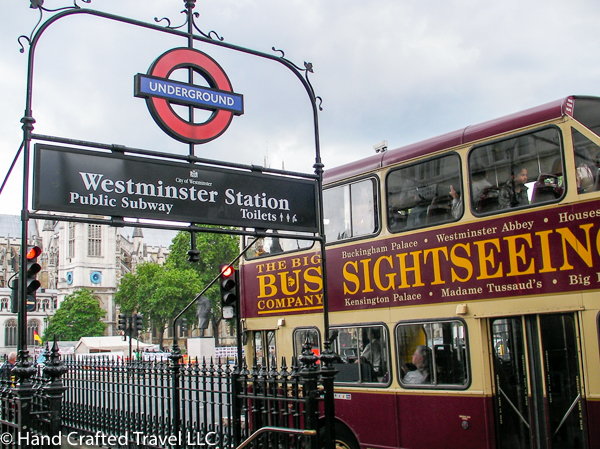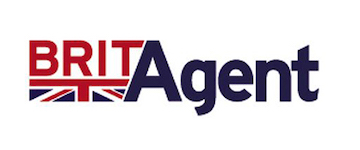Getting Around in London
London has one of the most highly developed public transport systems in the world – an absolute necessity in a city with a population of between 9 and 14 million (depending on how wide you draw the circle). A car is a useless headache. Go local, and get comfortable using public transport, in all its forms.
The Underground
The biggest people mover in the city is the subway. Officially it’s called the London Underground, but everybody calls it the Tube, due to the shape of the tunnels and trains. It’s an incredibly dense network, with 11 interconnecting lines, all color-coded. In central London – the area of most interest to tourists – you’ll never be more than a few blocks from a Tube station. Trains run from around 5:00 until 00:30, with some lines running even later, especially on Fridays and Saturdays. They usually come through every 5 minutes or so, though at rush hour they can be more frequent (like every minute or two).
There are a few drawbacks to the Tube, though.
- One – it’s extremely crowded during peak hours (6:30–9:30, 16:00–19:00). Do everything you can to avoid traveling on the Tube during these hours.
- Two – it’s one of the oldest systems in the world. Though modernization and maintenance are on-going, breakdowns and delays are not uncommon.
- Three – you don’t get to see anything of London while you are traveling (but I think this is more than made up for in time spared).
- Four – it’s expensive, compared to public transport in most European cities. Three or four of you traveling together may travel more cheaply with a cab or minicab.
Tips:
- Always stand on the right when using the escalators at Tube stations, and keep some space free on your left. People late for the office will be running up or down on the left side – if you’re standing in the way, they may let you know about it with some colorful local language.
- The famous Tube map is a beautiful piece of graphic design, but can be misleading when it comes to the distance between stations. You may find yourself riding ten minutes on the Tube, changing trains once or twice in the process, only to find that you could have walked between A and B in a few minutes.
- If you are using a contactless payment method (see below), be sure to tap in AND out.
- Oh, and mind the gap.
Buses
London’s red double decker buses are as iconic as the old red public telephone boxes, and just about as useful. Ride a double decker one time for the experience and for the view it offers, but don’t expect to get anywhere quickly. Even though there are miles of dedicated bus and taxi lanes, London traffic still moves like maple syrup fresh out of the freezer. A recent study found that traffic in central London averages just over 7 miles per hour – slower than it was in the late 1800’s.
The one time when buses come in handy is when you’ve had a late night out – a really late night – and the Tube has shut down. Night buses operate on many major routes from around midnight until 5:00.
Tips:
- It’s not possible to pay your bus fare on-board in cash. You either need to have a paper ticket, a Travelcard, or some form of contactless payment (see Fares below).
- Buses do not operate in zones. Any Travelcard is valid for any bus journey within Greater London regardless of the zone(s) it covers.
- In British-speak, an intra-city bus is called a ‘bus’, while an inter-city bus or tour bus is called a ‘coach’.
DLR
The Docklands Light Railway connects to several Underground stations and has very modern, automated trains that serve the east London Docklands area. Once a seedy backwater, the redeveloped Docklands is home to lots of modern office buildings and apartments. You’re only likely to use it if you want to visit Greenwich (Royal Observatory, Cutty Sark, Old Royal Naval College, National Maritime Museum). Trains run from 5:30 to 00:30 Monday to Saturday, and 7:00 to 23:30 on Sunday.
Tips:
- If you’re a Beatles fan, the Abbey Road DLR station is not even remotely close to Abbey Road Studios, scene of the famous album cover (instead take the Jubilee line to St. John’s Wood Tube station, or Bakerloo line to Maida Vale Tube station).
Boats
The river is the heart of London. It’s why the city is here. I make it a point to ride a river boat at least once on every trip to London, either on a River Bus to get from A to B, or on a River Tour to see the city from another vantage point. River Bus services are operated by MBNA Thames Clippers, and run about every 20 minutes in central London, from morning to early evening (schedules vary greatly, depending on route).
The routes I use the most are:
- Tower Pier – London Eye or Westminster Pier
- Central London piers – Greenwich Pier
- Richmond or Turks piers – Hampton Court Pier
Multiple companies run River Tours, including MBNA Thames Clippers, City Cruises, and Thames River Services. If you’re looking for something a bit more thrilling, check out the Thames RIB Experience.
The Overground
Believe it or not, there is also a London Overground. These above-ground trains form a circular line serving London’s suburbs. If you’re a first-time visitor you can pretty much forget about the Overground, unless you are trying to save money by staying in the suburbs. Overground trains run from around 5:00 to midnight Monday to Saturday, and from around 7:00 to midnight on Sunday.
Trams
London also has some trams that serve south London, but they’re of virtually no use to tourists.
Other options
Taxis. London’s black cabs are just as famous as the double decker buses (though fewer and fewer of the cabs are actually black). They seem to be everywhere, and are easily hailed on the street. Taxi fares usually work out to around £1 per minute of travel.
Minicabs. Minicabs are private cars with drivers. They function much like a taxi and are often cheaper, but they are not allowed to pick-up passengers without a reservation. Numerous apps and toll-free numbers allow you to book a minicab at anytime, and it will show up moments later. My favorite minicab company is Addison Lee, which has an Uber-like app for smartphones (without the Uber-like surge pricing). Using the app you can get a quote, pay for your ride, and it will give you the license plate number of the car and tell you how many minutes until your driver arrives, as well as showing you a map with the car’s location in real-time.
Your feet. Last, but not least – you may just find that you don’t need public transport all that much. Central London is surprisingly compact and walkable. With a well-designed plan for your sightseeing, you shouldn’t need to ride the Tube or take a taxi more than once or twice per day.
Tips:
- Keep in mind that cabs are subject to the same slow-flowing traffic as buses – though, unlike buses, cabs aren’t on a fixed route, so they can bob and weave through side streets to avoid jams.
- Most black cabs and minicabs can handle up to five passengers, and some will hold six.
Public Transport Fares
Greater London is divided into concentric rings, forming nine zones (download a map with the zones). Zone 1 covers most of central London, with Zone 2 encompassing the few areas of tourist interest outside of Zone 1. If you are staying in central London, the only time you might go beyond Zone 2 would be for Heathrow Airport (Zone 6), or to some special interest sight, like Kew Gardens or Wimbledon (both in Zone 3).
All forms of public transport are integrated into a single fare system, so the same ticket is good on any of them. You pay for tickets either by buying paper tickets, or by using some form of contactless payment (more about this below). Fares vary based on the number of zones you travel through, the transport service you use, the day you travel and the time of day you travel (peak or off-peak).
This all sounds so complicated you may be tempted to just hail a taxi, but it’s really not that bad. I’m going to simplify things a bit and present some scenarios based on average travelers. If you want the full picture, take a look at all of the fare options on the Transport for London web site.
You only plan to ride the subway once or twice during your time in London
Buy single paper tickets.
For Zones 1 & 2 these are £4.90, and are valid any time of day. Single tickets can be purchased at ticket offices or from ticket machines at Tube, DLR, London Overground, TfL Rail and National Rail stations, and you can pay in cash or with a credit card.
You plan to travel on public transport at least three times, but only one day
Buy an Anytime Day Travelcard for Zones 1-4.
Travelcards are paper tickets you can buy for different time periods and travel zones. With a Travelcard, you can travel as much as you like, as often as you like on bus, Tube, tram, DLR, London Overground, TfL Rail and most National Rail services in London in the zones you have paid for.
Day Travelcards come in two flavors, Anytime and Off-Peak (Off-Peak Travelcards are valid only after 9:30 on weekdays, anytime weekends and public holidays). Assuming you stay within Zones 1-4, there is no difference in cost between Anytime or Off-Peak Day Travelcards up to and including Zones 1-4. All of the variations are £12.10, so you might as well get the most inclusive one, the Anytime Day Travelcard for Zones 1-4.
Day Travelcards are available at Visitor Centres, or from ticket offices and ticket machines at Tube, DLR, London Overground, TfL Rail and National Rail stations. You can buy the Travelcard with cash or with a credit card.
You plan to be in London for a week, traveling on public transport at least twice per day
Buy a 7 Day Travelcard.
Valid for seven days from the start date (printed on the ticket), any time of day. You’ll need to decide how many Zones you plan to visit, but if you’re in London for a week you are probably going to be including places like Greenwich, Kew Gardens (both in Zone 3), or Richmond (Zone 4). If you want your Travelcard to cover your journey to and from Heathrow Airport, you’ll need Zones 1-6.
- Zones 1-2 - £32.40 (£4.63 per day)
- Zones 1-3 - £38.00 (£5.43 per day)
- Zones 1-4 - £46.50 (£6.64 per day)
- Zones 1-5 - £55.20 (£7.93 per day)
- Zones 1-6 - £59.10 (£8.44 per day)
7 Day Travelcards are available at Visitor Centres, or from ticket offices and ticket machines at Tube, DLR, London Overground, TfL Rail and National Rail stations. You can buy the 7 Day Travelcard with cash or with a credit card.
You plan to be in London for 3 to 5 days, and will be using public transport more on some days than others
Use some form of contactless payment (see below). Really this describes most visitors to London
You are comfortable with technology
Use some form of contactless payment (see below).
You hate dealing with technology
Use single paper tickets or Travelcards.
Contactless Payment
Most locals traveling on public transport use some form of contactless payment. When boarding any form of public transport all you have to do is tap a special contactless card on a yellow disk, and Transport for London figures out the rest. Single rides in Zones 1-2 are typically £2.90 during peak hours, £2.40 off-peak, but the important point is that you don’t have to worry about it. Transport for London will charge you the appropriate fare, regardless of the type of transport, number of zones, or time of day. If you use public transport multiple times per day, you benefit from what is called ‘fare capping’ – your total charge for the day will never be more than the daily cap, which is £6.50 in Zones 1-2.
So what is contactless payment?
You trigger contactless payment with:
- A credit card with a contactless chip. Note that this is different than the EMV chips that are common in Europe, and just now appearing in credit cards in the US. A contactless credit card will have a special logo showing the contactless symbol (like a wifi icon, only sideways). Contactless credit cards are not very common in the US. Keep in mind that US-issued contactless credit cards may charge a foreign transaction fee (typically 3%, check with your card issuer for details on any foreign transaction fees).
- An Oyster Card. This is a pre-paid card that you can re-load as needed. You can buy an Oyster Card or add more value to your card at Visitor Centres, Tube and rail stations, or at Oyster Ticket Stops (thousands of retail shops, newsstands and kiosks all over London). There’s a £5 deposit for the card, which is refunded if you return the card. You can also have any balance refunded, up to £10, or keep the card for future travels (the credit never expires), or give it to a friend.
- A Visitor Oyster Card. This is a special Oyster Card designed to fleece…I mean help tourists. It works just like an Oyster Card, except that it has a non-refundable £3 cost, meaning that at the end of your trip it becomes a souvenir. You can’t actually buy it in London – you have to order it on-line (visitorshop.tfl.gov.uk) and have it shipped to your home (£4.25 to £12.75, depending on delivery method), adding to the overall cost. To be fair, it does include discounts at some of London’s finest chain restaurants and shops, none of which I find interesting. If you’re considering using an Oyster Card for your travels, I’d just stick to the normal, local variety. The only exception is if you are traveling with kids ages 11-15.
- A smartphone or watch with Apple Pay or Android Pay. All recent iPhones (iPhone 6 or later) and most Android phones have contactless technology built in, and allow you to use your regular credit cards for contactless payments. The only hassle to this is having to get your phone out and activate the Apple Pay or Android Pay feature each time you need it, but if you know how to do it quickly, this isn’t much of a problem. Keep in mind that credit cards you have linked to Apple Pay or Android Pay may charge a foreign transaction fee (typically 3%, check with your card issuer for details on any foreign transaction fees).
Tips:
- Be sure you see a green light on the yellow contactless pad after tapping.
- Travel off-peak. Not only is it cheaper, it’s less crowded. Peak hours are 6:30–9:30 and 16:00–19:00, Monday to Friday.
- On Tube and rail services remember to tap in AND out, or may be charged the maximum fare.
- On buses and trams you only need to touch your card on the card reader at the start of your journey.
- On River Bus services only touch in on the yellow card reader when asked to board by a member of MBNA Thames Clippers staff and remember to touch out again at the end of your journey, or when changing boats.
Visitor Centres
Visitor Centres are the place to buy your Oyster Card and Travelcards, as well as get loads of other information about London. Most Visitor Centres are open 8:00 to 18:00, though some are less and some longer. Where are they?
- Heathrow Terminal 2,3 Tube station
- Gatwick Airport
- Victoria National Rail station
- King’s Cross St. Pancras Tube station
- Piccadilly Circus Tube station
- Liverpool Street Tube station
- Paddington National Rail station
- Euston National Rail station
Traveling with kids
If you’re traveling with children aged 11-15, buy them a Visitor Oyster card before you leave home. When you arrive in London, ask a member of the Transport for London staff to add a Young Visitor discount to the Visitor Oyster card. This can be done at Visitor Centres, most Tube stations, or the Victoria National Rail station ticket office.
With the Young Visitor discount your child gets fares that are half the adult rate for up to 14 days.
Children under 11 travel free on buses and trams. Children under 11 also travel free on Tube, DLR, London Overground, TfL Rail and some National Rail services when accompanied by a fare-paying adult (up to 4 children per adult).
For more information about public transport in London, including maps, fares and live details about schedule changes or maintenance delays, visit the Transport for London web site.
Compare Rental Cars
Find great deals on hotels
Eurailpasses and Train Tickets
With over 40 years of travel experience, we are experts in many areas
Hand Crafted Travel respects your privacy. Learn more about our Privacy Policy.
STAY CONNECTED
TRAVEL TIPS
ABOUT US
CONTACT
Hand Crafted Travel LLC
5730 N 1st Street
Ste 105 PMB 145
Fresno CA 93710
Tel: +1 559 447 8441
E-mail
CST #2094789-40
Some offers that appear on this website are from companies from which Hand Crafted Travel® LLC may receive compensation. This compensation may impact how and where products appear on this site (including, for example, the order in which they appear). Please view the Privacy Policy for more information.
Opinions expressed here are the author’s alone, not those of any advertiser or affiliated company. Any product claims, statistics, quotes or other representations should be verified with the manufacturer or service provider.
All content © 1992 – 2022 Hand Crafted Travel LLC










